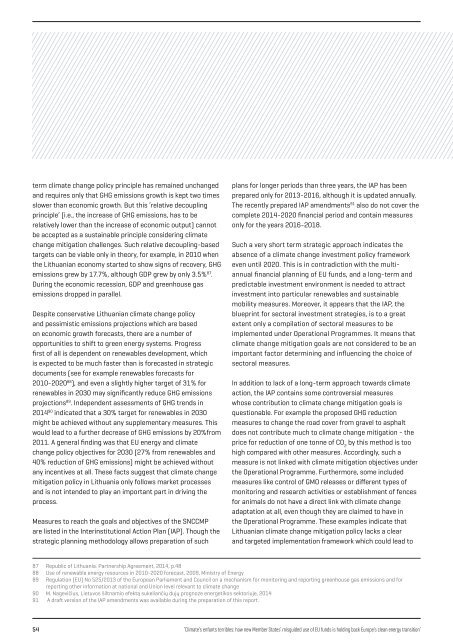ENFANTS TERRIBLES
enfants-terribles
enfants-terribles
Create successful ePaper yourself
Turn your PDF publications into a flip-book with our unique Google optimized e-Paper software.
term climate change policy principle has remained unchanged<br />
and requires only that GHG emissions growth is kept two times<br />
slower than economic growth. But this ‘relative decoupling<br />
principle’ (i.e., the increase of GHG emissions, has to be<br />
relatively lower than the increase of economic output) cannot<br />
be accepted as a sustainable principle considering climate<br />
change mitigation challenges. Such relative decoupling-based<br />
targets can be viable only in theory, for example, in 2010 when<br />
the Lithuanian economy started to show signs of recovery, GHG<br />
emissions grew by 17.7%, although GDP grew by only 3.5% 87 .<br />
During the economic recession, GDP and greenhouse gas<br />
emissions dropped in parallel.<br />
Despite conservative Lithuanian climate change policy<br />
and pessimistic emissions projections which are based<br />
on economic growth forecasts, there are a number of<br />
opportunities to shift to green energy systems. Progress<br />
first of all is dependent on renewables development, which<br />
is expected to be much faster than is forecasted in strategic<br />
documents (see for example renewables forecasts for<br />
2010-2020 88 ), and even a slightly higher target of 31% for<br />
renewables in 2030 may significantly reduce GHG emissions<br />
projections 89 . Independent assessments of GHG trends in<br />
2014 90 indicated that a 30% target for renewables in 2030<br />
might be achieved without any supplementary measures. This<br />
would lead to a further decrease of GHG emissions by 20%from<br />
2011. A general finding was that EU energy and climate<br />
change policy objectives for 2030 (27% from renewables and<br />
40% reduction of GHG emissions) might be achieved without<br />
any incentives at all. These facts suggest that climate change<br />
mitigation policy in Lithuania only follows market processes<br />
and is not intended to play an important part in driving the<br />
process.<br />
Measures to reach the goals and objectives of the SNCCMP<br />
are listed in the Interinstitutional Action Plan (IAP). Though the<br />
strategic planning methodology allows preparation of such<br />
plans for longer periods than three years, the IAP has been<br />
prepared only for 2013-2016, although it is updated annually.<br />
The recently prepared IAP amendments 91 also do not cover the<br />
complete 2014-2020 financial period and contain measures<br />
only for the years 2016-2018.<br />
Such a very short term strategic approach indicates the<br />
absence of a climate change investment policy framework<br />
even until 2020. This is in contradiction with the multiannual<br />
financial planning of EU funds, and a long-term and<br />
predictable investment environment is needed to attract<br />
investment into particular renewables and sustainable<br />
mobility measures. Moreover, it appears that the IAP, the<br />
blueprint for sectoral investment strategies, is to a great<br />
extent only a compilation of sectoral measures to be<br />
implemented under Operational Programmes. It means that<br />
climate change mitigation goals are not considered to be an<br />
important factor determining and influencing the choice of<br />
sectoral measures.<br />
In addition to lack of a long-term approach towards climate<br />
action, the IAP contains some controversial measures<br />
whose contribution to climate change mitigation goals is<br />
questionable. For example the proposed GHG reduction<br />
measures to change the road cover from gravel to asphalt<br />
does not contribute much to climate change mitigation - the<br />
price for reduction of one tonne of CO 2<br />
by this method is too<br />
high compared with other measures. Accordingly, such a<br />
measure is not linked with climate mitigation objectives under<br />
the Operational Programme. Furthermore, some included<br />
measures like control of GMO releases or different types of<br />
monitoring and research activities or establishment of fences<br />
for animals do not have a direct link with climate change<br />
adaptation at all, even though they are claimed to have in<br />
the Operational Programme. These examples indicate that<br />
Lithuanian climate change mitigation policy lacks a clear<br />
and targeted implementation framework which could lead to<br />
87<br />
88<br />
89<br />
90<br />
91<br />
Republic of Lithuania. Partnership Agreement, 2014, p.48<br />
Use of renewable energy resources in 2010-2020 forecast, 2009, Ministry of Energy<br />
Regulation (EU) No 525/2013 of the European Parliament and Council on a mechanism for monitoring and reporting greenhouse gas emissions and for<br />
reporting other information at national and Union level relevant to climate change<br />
M. Nagevičius, Lietuvos šiltnamio efektą sukeliančių dujų prognozė energetikos sektoriuje, 2014<br />
A draft version of the IAP amendments was available during the preparation of this report.<br />
54<br />
‘Climate’s enfants terribles: how new Member States’ misguided use of EU funds is holding back Europe’s clean energy transition’


